There is a lot of confusion surrounding the symptoms of sciatica and what sciatica actually is. This is partly due to the fault of the media and partly due to the fault of the medical profession. It is also due to hundreds of years worth of misinformation spreading throughout society about this condition. But don’t worry! We are here to help – today, we talk about sciatica symptoms, their causes and attempt to point you in the right direction to getting them sorted.
Aims of this post:
- To provide an in-depth comprehensive guide to sciatica symptoms
- To discuss how back pain and sciatica symptoms occur, and where to go after a diagnosis
- To explain when you need to seek out immediate medical attention based on your symptoms
- To point you in the right direction for how to get it sorted!
Before we dive in, please be aware that we are part of the Amazon Affiliate programme. This page may contain Amazon affiliate links, so if you choose to purchase a product for your sciatica that we recommend through a link on this page, we will receive a small commission at no extra cost to you. This helps us keep Overcome Sciatica alive! Thank you for your support. Please be assured that we only ever recommend products that we truly believe can help.
The Ultimate Guide to Sciatica Symptoms
What is Sciatica?
The term “sciatica” actually means one very simple thing – pain in the leg related to a nerve. Strictly speaking, “sciatica” refers to the sciatic nerve, which is responsible for the pain down the back of the leg that can travel all the way to the toes.
Sciatica is not a “disease” in and of itself. “Sciatica” simply describes a set of symptoms, which we will come to later.
There are many potential causes for sciatica symptoms. A large proportion of these causes are due to a problem within the lower back. However, the location of the problem can also be the hip, or even further down the leg.
Without doubt, the lower back (or the “lumbar spine” if speaking to a medical professional) is the area that causes the most cases of sciatica. Let’s learn how the lower back is responsible for most sciatica symptoms…
The Lower Back
The lower back is made up of 5 bony segments, called vertebrae, all stacked upon one another. Between these vertebrae are the intervertebral discs, tough sacs made up of strong fibres called “collagen”, combined with water and nutrients.
These discs are responsible for shock absorption through the spine, as well as lubrication of movement.
The joints that join these bony vertebral segments together are called “facet joints”. They allow the vertebrae above to move with the vertebrae below, with the assistance of a lubricating substance called “cartilage”.You’ve probably heard of cartilage before – it is the substance that wears away in the process called “arthritis”.
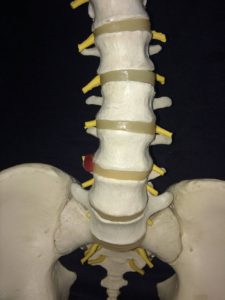
There are 24 vertebral bones in the spine, with 5 of them making up the lower back. In the centre of the vertebral bones within the lower back, runs the spinal cord.
When this reaches the bottom of the spine, it splits off into a network of nerves (called the “cauda equina” after the Latin term for a “horse’s tail” which refers to its appearance). You can see a really useful picture of the cauda equina HERE.
These nerves then leave the spine at each of the 5 lowest levels in the back, initially via a nerve root which then becomes a fully functional nerve.
This functional nerve then runs into the leg, supplying the skin with sensation and our muscles with the signals that allow them to work.
How Do Nerves Work?
To understand how sciatica symptoms occur, we must first understand how these nerves work.
The easiest way to get our heads around this is to imagine nerves as long cords in the body, that start in the spinal cord (which runs from the brain to the tail), and leave the spine through small gaps between the vertebrae.
Nerves send signals up to the brain from our body about touch, sensation and pain. Equally, the brain sends instructions down the nerves to our muscles, to make them move so we can walk, talk and eat.
You can think of the nerves as mini-motorways inside our body. On these motorways, the cars travelling down represent the signals that are sent from our brain to our limbs, and the cars that travel in the opposite direction represent the signals sent from our limbs to the brain.
When we have a healthy nerve, the signals travel smoothly, within the “speed limit”, and without running into any traffic.
Sciatica occurs when the transmission of these important signals is affected.
We will go further into detail on the topic of what problems can actually cause sciatica symptoms later in this post.
But now let’s talk about the sciatica symptoms that someone with sciatica may experience.
Sciatica Symptoms
This section will go over the well-known symptoms of this condition, as well as uncovering some of the lesser known sciatica symptoms, too.
- Pain in the leg: This is one of the classic sciatica symptoms. The pain that you feel follows the course of the affected nerve in your leg. If the sciatic nerve is affected, you feel pain down the back of the leg, sometimes all the way to the toes. This is because that is the path that the sciatic nerve takes.The classic sciatic pain we see starts from the back or buttock and runs all the way down the back of the leg in a shooting line. It is also possible for the pain to be felt in one area of the leg only. Often this is the case in the calf.The pain can be described as sharp and shooting, “like an electric shock”, but it is also possible for sciatica to be felt as a dull throbbing ache, too. If it is not the sciatic nerve that is affected, the pain can run down the side of the leg, or down the front of the leg. It can also run into the groin, too.
- Pins and needles or numbness in the legs or feet: This symptom is very common in people who suffer from sciatica symptoms, and is caused by the same thing that causes the leg pain.Often, the pins and needles or numbness will affect the same areas in the legs as the pain does. These sensory changes can range from a tingle, “fizzing”, or slightly “dull” feeling, to complete loss of sensation, depending on severity.
- Loss of strength in a muscle group in the legs: When the affected nerve gets compressed to a point that the signals within that nerve cannot be carried effectively to the muscles any more, loss of strength occurs. This can be quite a serious symptom, and if you feel this may be happening to you it is advisable to get a check-up from a doctor as soon as you can.
- Back pain: Back pain very often accompanies sciatica. This is because, usually, the problem that causes sciatica symptoms is actually within that person’s back. It is entirely possible to have the other sciatica symptoms without any back pain. Not all causes of back pain also cause sciatica.
Why do we get these sciatica symptoms?
This part will hopefully answer all the “why” questions you might have about the symptoms you are experiencing. Like we spoke about earlier, having a full understanding of why something happens helps us understand how best we treat it.
As we can see in the picture, our spines are very complex. We have 7 cervical vertebrae (bones in the neck), 12 thoracic vertebrae (bones in the mid-back), 5 lumbar vertebrae (bones in the lower back) plus 1 sacrum (tail bone).
Between each one of these vertebrae are the intervertebral discs, that we spoke about before. Each disc has a soft inner section – called the nucleus – and a tough outer section called the annulus.
The spinal cord runs through the vertebrae, protected by the strong bones, discs and ligaments that hold the spine together.
Branching off from the spinal cord we have nerve roots (seen clearly in the picture below) that leave the spine and re-converge to become the main nerves in the body. The main nerves within the legs all begin in the part of the spinal cord that sits in the lumbar spine (lower back).
You can see in the picture the nerve roots of the lower 4 vertebrae. The nerve roots are in yellow. The bottom 2 nerve roots (plus 3 from the sacral region lower down) will converge to make up the sciatic nerve.
The sciatic nerve is the biggest nerve in the human body. It is roughly three-quarters of an inch across and runs all the way from the lower back to the toes, via the back of the leg.
Going back to the motorway analogy we used earlier, the sciatic nerve is like a huge motorway, with cars (signals) running up and down its length constantly.
So What Goes Wrong in Sciatica?
Something that has become obvious to the medical profession as a whole is this: nerves do not like to be touched!
Touching, pinching or compressing a nerve causes reactions around that area, causing pain along the entire course of the nerve.
You will get sciatica symptoms from the direct contact but also a chemical reaction around that area which exacerbates these symptoms.
The chemical reaction that occurs when we compress a nerve, especially when disc material touches the nerve, is similar to the type of reaction we get when we are stung by a bee.
Chemical irritants, like “substance P” and “histamine” remain for some time in the affected area, causing further inflammation to the nerve root and pain along the course of the nerve.
Not a happy combination!
So, generally speaking, sciatica symptoms are caused by something touching, pinching or compressing the affected nerve. This usually happens in the lower back, as the lower back is where the nerve roots run through tight spaces. This leaves them vulnerable to being contacted if a structure in the back has invaded the space within which the nerve runs through.
So what goes on to cause us sciatica symptoms?
The structures in the back that can affect the nerves are:
- The intervertebral discs: The tough outer part of the intervertebral discs can develop micro-tears over time through repetitive movements under load. These micro-tears can develop into “bulges”, which occur when pressure causes the inner material in the disc to push into these weakened zones. These bulges can encroach on the tight spaces that the nerve roots run through.In a worst case scenario, the inner material of the disc can actually leave the side of the disc through these weakened areas, causing a chemical reaction around the nerve root leading to sciatica. This often gets worse when a person bends forward, as pressure on the front of the disc causes the inner material to “bulge” backwards towards the nerve root, irritating it and causing sciatica symptoms.
In the above picture, you can see what it looks like when a disc bulges slightly. The red area represents the bulge, and this will press on the yellow nerve root, causing pain all along the course of the nerve.
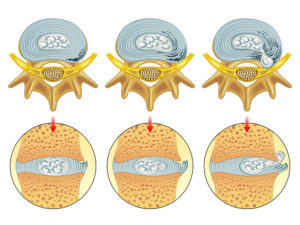
- General age-related changes to facet joints and discs: As we age, our discs dry out and lose height, the bone around our joints thickens, our joints become stiffer and we lose the cartilage that helps to lubricate movement in our spines.All of these changes equate to a smaller and less lubricated space for the nerve roots to exit the spine from, causing them to become compressed. When this compression becomes more severe, it leads to a condition called “spinal stenosis”.
- Piriformis syndrome: In some people, the sciatic nerve runs through a muscle in the buttock region called the Piriformis. When this muscle gets tight, the nerve can become compressed in the buttock, causing similar pain and numbness to the other types of sciatica.
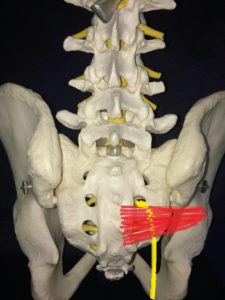
- Fractures: In rare cases, a fracture of one of the vertebrae can cause a compression on a nerve root. This can happen following trauma, like a fall, but if someone has a condition called “osteoporosis” then fractures can occur spontaneously. Osteoporosis is a condition that causes a thinning of the bones and is more common in women and the elderly.
- Tumour or growth: Very rarely, a cyst, tumour or other lesion can occur in the spine which then leads to a nerve root compression. This type of problem is luckily not very common. We will talk about “red flags” for tumours later in this post. If you’re really worried about this being a cause for your sciatica, please go and seek help from your doctor, who can hopefully put your mind at rest.
When Should You Be Worried?
This is a very important section of this post. For every patient that I assess with sciatica, it is imperative that I ask these questions prior to commencing any treatment, in an attempt to rule out any serious problems that may be causing their sciatica.
If you answer a “yes” to any one of the questions in this section, you should contact your doctor immediately.
These problems are thankfully very rare, but they do occur, and I have unfortunately had patients with these issues. It is important that you understand what to look out for, and that you know what to do if any of these signs or symptoms do arise in the future.
You can also check out my guide on How to Tell if You Need a Scan when you have sciatica.
Cauda Equina Syndrome
When one of the structures in the spine, like an intervertebral disc, compress not just the nerve root but the actual bundle of nerves in the central canal, the condition cauda equina syndrome occurs. The word cauda equina translates literally to horse’s tail and it gets this name because of the appearance of the cord at the bottom of the spine.
This problem will usually cause an array of alarming symptoms.
Along with back pain and sciatica, these include one or more of (not exhaustively):
Altered sensation to the “saddle” area around your bottom and privates
Do you have any numbness in the area of your bottom that touches the seat when you sit down? Do you have any numbness when you wipe your bottom?
This symptom can occur when the nerves that supply the skin around this area of the body become compromised. It can indicate a nerve compression which requires immediate attention.
Loss of control of bladder or bowel function. This includes both incontinence and retention (not being able to pee)
Do you have any problems with your bladder and bowel function? Do you try to pee but find it hard to start the flow? Have you had any “accidents” recently where you have gone without knowing?
Again, this can indicate a serious compression in the lowest nerves coming from the spine. These nerves control bladder and bowel function. If the compression is not relieved quickly, there are usually permanent consequences.
Loss of strength in the legs
Do you feel like your knee, hip or ankle wants to give way when you walk? Do you feel like you are losing strength in your limbs?
A loss of strength in the legs occurs when the innermost fibres of the nerve are squashed. This prevents the signals from reaching their target muscle normally.
In cauda equine syndrome, you may also experience the pins and needles and numbness associated with routine sciatica. The symptoms are more likely to occur in both legs with cauda equina.
Cauda equina is a medical emergency and requires immediate investigation. It is best practice to contact your local emergency centre if you have any of these symptoms. Do this as quickly as you can as the quicker you act, the better the outcome is likely to be!
Signs of serious illness
Sometimes, a serious illness can cause sciatica symptoms. A cancerous tumour within the lower back can compress one of the nerve roots and cause the symptoms associated with sciatica. Again, this is rare!
It is extremely uncommon for a person to experience “primary” cancer in their lower back – “primary” describes the first place within the body that the cancer occurs. Usually, people who suffer from cancer affecting the lower back have had either bowel, bladder or cervical cancer first.
Some of the other serious illnesses that can affect the lower back and cause sciatica include Tuberculosis and discitis (an infection of an intervertebral disc).
The signs and symptoms that can suggest a serious illness include (not exhaustively):
- Rapid, unexplained weight loss
- Night sweats (not just a bit clammy from time to time – usually quite extreme sweating)
- Loss of appetite
- General feeling of being unwell
- Unremitting night pain when laying down
- History of cancer
If you have any of the above symptoms, it is advisable to get an assessment with your doctor as soon as you can. Of course, the above symptoms can be caused by non-serious issues too, but it is always best to get checked out if you are in any doubt.
If you don’t have any of the above symptoms but are in severe pain which has not subsided over the past few weeks, I would recommend getting checked out anyway. If you have the necessary investigations and your doctor is happy for you to proceed, you can then come back to this website and continue to follow the advice within.
So there are the common causes of sciatica, and an explanation as to why each one of these causes leads to the pain we feel in the back and legs.
If you found this article useful, please consider sharing with anyone else that you know to be suffering from sciatica or back pain to help them out, too!
If you want more information about sciatica and – more importantly – how to overcome it, why not sign up for my regular newsletter. You’ll get all my best tips straight into your inbox as soon as they are released!
As always, thanks for reading and feel free to leave any comments in the box below.
Got a question? Submit it to: will@howtogetridofsciatica.com
The information on Overcome Sciatica should never be used as a substitute for medical advice from a doctor. Never put into action any tips or techniques from Overcome Sciatica without checking with your doctor first. Please see full terms of use here.

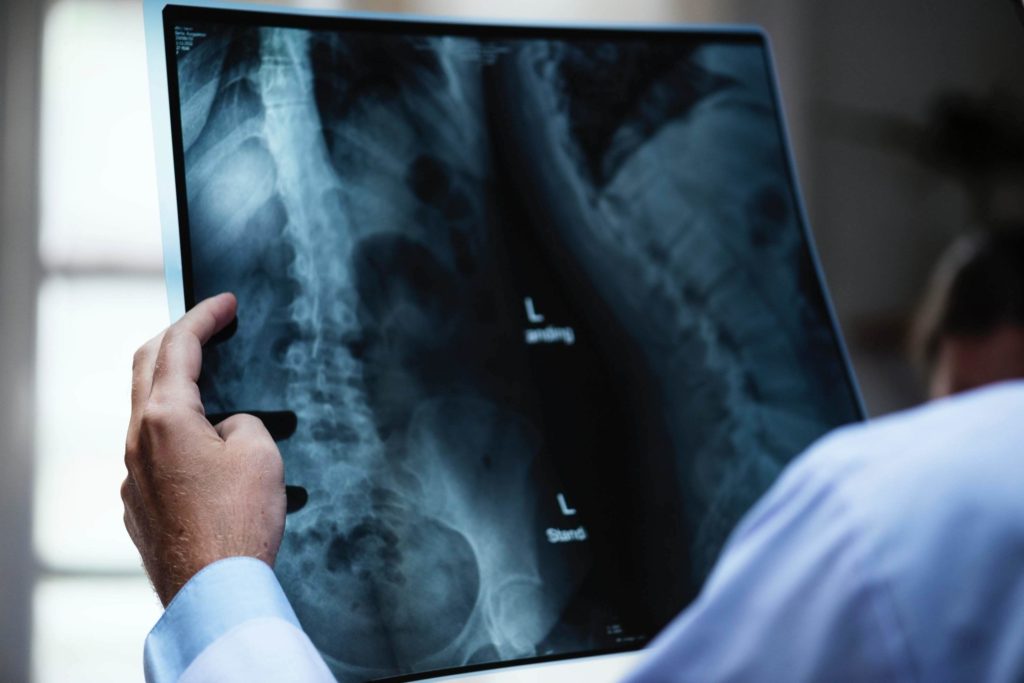

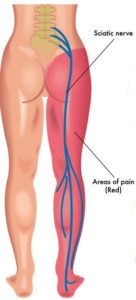
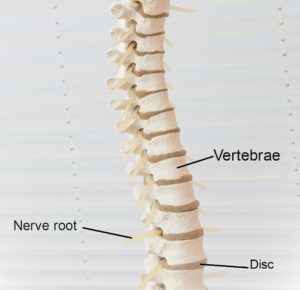
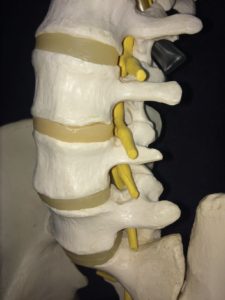

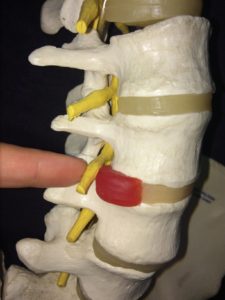
very interesting one thing most of us who suffer this problem would ask is it life threatening ?.
Hi Peter,
Thanks for your question! While sciatica is extremely painful, it is not life threatening. The most serious progression of sciatica, cauda equina syndrome, can be limb-threatening but not directly life threatening either.
Hope this helps!
Will
most informative to say the least
Thank you
Thanks for your kind words Stewart!
Will
thank you
Thank you for the excellent explanation. Presently and for the 1st time I’m feeling this terrible pain specially when walking. Due to Covid-19 it’s rather difficult to get a doctors appointment so I’ve asked for support in a pharmacy and they suggested ibuprofen. Took 1 pill and I’m looking forward to swallow the 2nd one. I’m 72 years old so maybe I will experience more crisis like this unfortunately. Do you have any suggestions to try to avoid these crisis? Thank you!
More than glad to have found this article. Very insightful and easilyeasy to understand details.
Thank you.